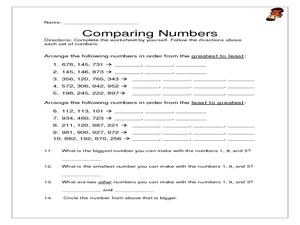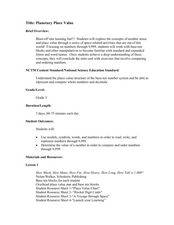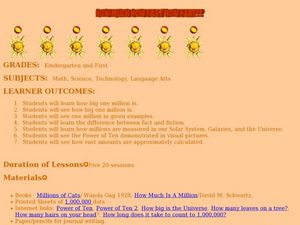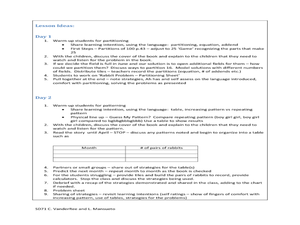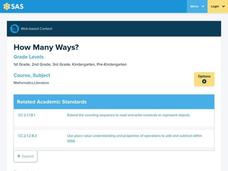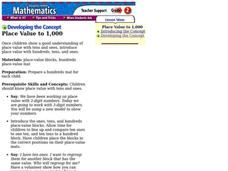Curated OER
Investigation - What Does 1,000 Look Like?
Second graders determine what 1,000 items look like. In this math investigation lesson, 2nd graders collect 1,000 items and determine the best way to count them by tens and hundreds. They can use stickers on notecards to count to 1,000....
Curated OER
Calculator Count to 1000
Students develop an understanding that large numbers are made up of smaller ones. They develop multiples by skip counting with a calculator to 1000. They share their lists and patterns.
Curated OER
Arranging Numbers in order up to 1,000
Third graders arrange numbers up to 1,000. In this arranging numbers instructional activity, 3rd graders play a game to try and build the biggest number they can using number tiles. Students work in groups to draw number tiles from...
Alabama Learning Exchange
Place Value Party
Help your young mathematicians master three-digit place value with a hands-on activity that builds on their social orientation. They create a place value house from construction paper and sort "number friends" according to which house...
Primary Junction
Adding Tens
Build on your learners' confidence in quick addition as they discover strategies to add tens to two-digit numbers. After reviewing counting by 10's, they discuss tactics to add multiples of 10 to other numbers. They visualize how to...
Curated OER
Using Groups of Ten to Solve Problems
Upper graders solve math problems involving multiplication using specific strategies. They will use base-ten blocks, hundreds charts, and number lines to solve multiplication problems. Then they will practice several of the strategies...
Curated OER
Arranging Numbers from 1 to 5
Kindergarteners arrange manipulatives or everyday objects in groups of one through five. They identify groups seen in pictures of nature and compare same numbers of different objects.
Houghton Mifflin Harcourt
Place Value to 1,000
Second graders stack cubes and learn how to group them in order to understand place value.
Curated OER
Ordering Numbers to 1,000
In this ordering numbers to one thousand worksheet, learners, working with a partner, calculate the answers to eight word problems involving ordering numbers to one thousand.
Curated OER
Mathematics Within: Algebraic Processes and Its Connections to Geometry
Students analyze multiple strategies of multiplication: clustering, area model, breaking apart/decomposing, etc. They create their own strategies to approaching multiplication problems and share them with their classmates. Discussion...
Curated OER
Planetary Place Value
Third graders explore place value to the ten thousands place. This incredibly thorough, 24-page lesson has learners construct, order, and compare numbers to 9,999. This three-day lesson includes reteaching and extension activities...
Curated OER
How Much, How Fast, How Far?
Students investigate the concept of the number one million. In this number concepts lesson, students read the book How Much is a Million? and brainstorm questions, such as "how many leaves are on a tree" and "how many hairs are on your...
Curated OER
Too Many Tens
Students practice grouping in different ways by putting numbers up to 1,000 in the correct place value. In this place value lesson plan, students estimate items in a jar and then count them out by grouping them by 10s.
Curated OER
The Rabbit Problem
Students notice a number pattern in the book The Rabbit Problem by Emily Gravett. In this number pattern lesson, students represent and describe numbers appropriate to their grade level.
Curated OER
Finding Sums to 6
Students explore the additive identity property where they add multiple numbers to get to the number 6. For this number 6 lesson plan, students also work on their addition charts.
Pennsylvania Department of Education
How Many Ways?
Students estimate the amount of money they have in groups of pennies, nickels, and dimes. In this money lesson plan, students then count up the amounts they have and exchange money amounts.
Curated OER
Volume
Learners, after reviewing the measuring of the lengths of sides of different shapes along with the calculation of their perimeters and areas, encounter what it means by the 'perimeter' of a polygon. They practice measuring units of...
Curated OER
Counting Animal Populations
Students learn how to count animal populations by the Mark and Recapture method. In this counting animal populations lesson plan, students begin by predicting amounts of different candies in a jar. Students then simulate using beans, two...
Curated OER
200 Years and Counting: How the U.S. Census Tracks Social Trends
Students examine the process of census taking in the United States. In this "200 Years and Counting" lesson, students examine the data collection process, look at an example of a census form, analyze data, and learn what the information...
Curated OER
Book Title: Ten Flashing Fireflies
This lesson engages learners in a variety of activities to build 1 to 1 correspondence, estimation, and problem solving skills. They discuss problem solving strategies, hear the story Ten Flashing Fireflies, compose their own word...
Curated OER
Place Value to 1,000
Second graders study the concept of place value with hundreds, tens, and ones. In the place value lesson, 2nd graders demonstrate their prior knowledge of place value with tens and ones. Students are then introduced to place value with...
Laboratory for Atmospheric and Space Physics
Jupiter’s Relative Size
How do you properly illustrate the extreme size difference between two planets—Earth and Jupiter? With the help of jellybeans, of course! Create a scale model of Jupiter's mass compared to Earth using a fishbowl, 1,400 beans, and a...
Code.org
Binary Numbers
All you need is a zero and a one. Build pupils' understanding of binary values and number systems to gain familiarity with binary numbers. Using a hands-on activity and technology, scholars learn how the binary system works and its...
Curated OER
How Much Is On The Floor?
Students estimate the number of items in a group. In this estimation lesson, students are presented with random objects to clean up. Students estimate how many items are present and then compare the actual number of items to their...


